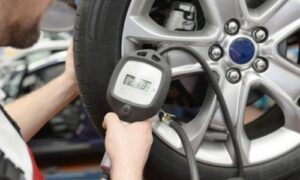Introduction
Painting your car at home can be a rewarding DIY project that enhances its appearance and protects it from environmental elements. While it may seem daunting, you can achieve professional-looking results with the right supplies, proper steps, and patience. This article will guide you on painting a car at home, from preparation to finishing touches.
Gathering Supplies
Painting your car at home requires gathering the right supplies to ensure a successful and professional-looking finish. Here’s a more detailed explanation of the necessary items:
Choosing the Right Paint
The first and most critical step is choosing the appropriate paint for your car. Automotive-grade paint is specially formulated to withstand the wear and tear of the road, weather conditions, and UV exposure. When selecting a color, consider the following factors:
- Color Match: Find the paint that matches your car’s color code. This ensures a seamless and uniform appearance, avoiding any visible discrepancies.
- Paint Type: There are different types of automotive paint available, such as enamel, acrylic, and urethane. Each type has its characteristics and level of durability. Urethane paints are famous for their high-quality finish and long-lasting performance.
- Compatibility: Ensure the paint you choose is compatible with your car’s surface. Some colors work better on specific materials, so check the label for compatibility information.
- Finish: Decide on the desired finish for your car. Options include gloss, matte, or metallic. Each finish creates a distinct appearance, so choose one that complements your style.
Essential Tools and Equipment
Having the right tools and equipment is crucial for achieving a professional result. Here are the essential items you’ll need:
- Sandpaper: Use a variety of sandpaper grits, including coarse, medium, and refined, to prepare the car’s surface for painting. Coarse grit removes imperfections, while finer grits create a smooth surface for the paint to adhere to.
- Masking Tape: High-quality masking tape is essential for covering areas that shouldn’t be painted, such as windows, trim, and lights. Proper masking prevents overspray and ensures clean lines.
- Primer: Applying primer is crucial for promoting paint adhesion and preventing rust formation. Choose a high-quality automotive primer suitable for your car’s surface.
- Spray Gun: An automotive paint spray gun allows for even and controlled paint application. Invest in a good-quality spray gun for optimal results.
- Compressor: The compressor supplies the air needed to power the spray gun. Ensure you have a compressor that provides sufficient airflow and pressure for your paint gun.
- Paint Filters: Paint filters help remove impurities and particles from the paint, ensuring a smooth and even application.
Preparing the Car
Proper preparation of the car’s surface is essential for a flawless and long-lasting paint job. This step involves washing, cleaning, sanding, and applying a primer to create an ideal canvas for the paint. Here’s a detailed explanation of each process:
Washing and Cleaning
Before starting the painting process, washing and cleaning the car’s exterior thoroughly is crucial. This step removes dirt, grease, and debris that may hinder paint adhesion and lead to an uneven finish. Follow these steps for effective washing and cleaning:
- Select a Car-Specific Detergent: Use a car-specific detergent that is gentle on the car’s paint and won’t damage the surface.
- Rinse the Car: Rinse the car entirely with water to remove loose dirt and debris.
- Wash with a Soft Sponge or Microfiber Cloth: Use a soft sponge or microfiber cloth to wash the car’s surface gently. Work from top to bottom to avoid any scratches caused by dirt particles.
- Pay Attention to Crevices: Clean hard-to-reach areas and crevices carefully to remove all dirt and grime.
Sanding and Priming
Once the car is clean and dry, the next step is to prepare the surface for painting by sanding and applying a primer. This process creates a smooth and uniform surface for the paint to adhere to. Follow these steps for sanding and priming:
- Select the Right Sandpaper: Choose a fine-grit sandpaper suitable for automotive use. Start with a coarser grit (around 320) to remove imperfections and old paint. Then, switch to finer grit (around 600) for a smoother finish.
- Sand the Surface: Gently sand the entire car’s surface, particularly areas with chipped or rough paint. Sand in a circular or back-and-forth motion, ensuring an even finish.
- Clean After Sanding: Clean the surface again to remove any sanding dust and particles. A clean surface ensures proper primer adhesion.
Automotive Paints & Coatings Market size was USD 14.33 billion in 2019 and is estimated to exhibit around 5.3% CAGR from 2020 to 2026.
Masking and Taping
Use masking tape and paper to cover areas like windows, trim, and lights you don’t want to paint. Proper masking is essential to avoid overspray and ensure a neat finish.
Applying the Paint
Spray Painting Techniques
Hold the spray gun consistently from the car’s surface and apply the paint in even, overlapping strokes. Start with lighter coats and gradually build up the paint layers.
Applying Multiple Coats
To achieve full coverage and vibrant color, apply multiple coats of paint. Allow each coat to dry before applying the next one. Avoid excessive paint application to prevent runs and drips.
Dealing with Imperfections
Addressing Runs and Drips
If you notice runs or drips in the paint, wait for it to dry completely. Then, sand the affected area gently and reapply the color as needed.
Sanding and Buffing
For a flawless finish, use fine-grit sandpaper to smooth out any imperfections. Follow up with buffing to restore the paint’s shine.
Applying Clear Coat
Apply a clear coat over the paint to enhance its glossiness and provide additional protection. Precise coat application is similar to the paint process, with even and light strokes.
Drying and Curing
Allowing Sufficient Drying Time
After completing the painting process, allow the car to dry for the recommended time. Avoid exposing it to dust or debris during this period.
Curing the Paint
Allow the paint to cure fully before using the car to achieve the best results. This process typically takes a few weeks, so you should avoid waxing or polishing the surface.
Finishing Touches
Removing Tape and Paper
Carefully remove the masking tape and paper once the paint is dry. Be cautious not to damage the fresh paint.
Reassembling the Car
Reassemble any parts that were removed before painting. Check that everything is secure and properly aligned.
Tips for a Professional Finish
Working in a Dust-Free Environment
Painting in a clean and dust-free environment reduces the risk of particles landing on the wet paint and ruining the finish.
Using Proper Safety Gear
Wear appropriate safety gear, including a respirator, gloves, and eye protection, to protect yourself from paint fumes and particles.
Common Mistakes to Avoid
Rushing the Process
Take your time and follow each step carefully. Rushing can lead to mistakes and subpar results.
Ignoring Proper Surface Preparation
Thoroughly prepare the car’s surface before painting to ensure a lasting and smooth finish.
Conclusion
Painting a car at home can be a gratifying and cost-effective project, yielding impressive results. With the right supplies, proper preparation, and careful execution, you can achieve a professional-quality paint job that revitalizes your car’s appearance and protects it from the elements.






